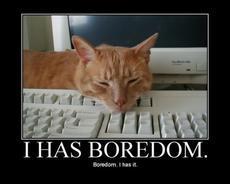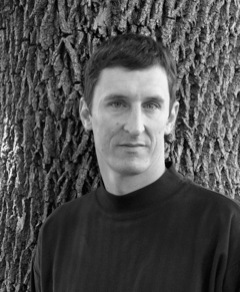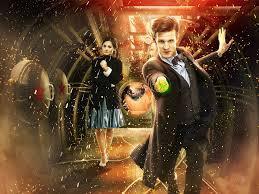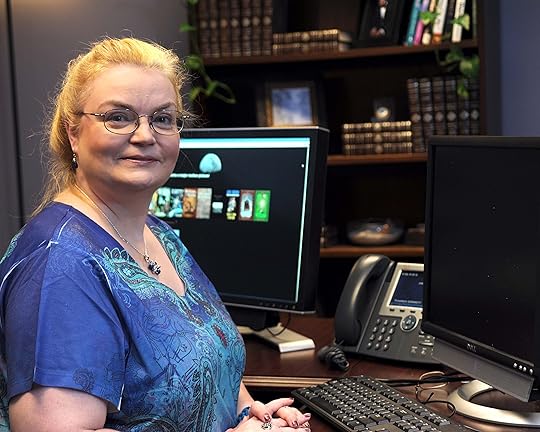Christine Amsden's Blog: Christine Amsden Author Blog, page 25
September 18, 2013
The Origins of the Displaced Detective
The Origins of the Displaced Detective
By Stephanie Osborn, The Interstellar Woman of Mystery
http://www.stephanie-osborn.com
I suppose the first thing you should know about me is that, well, I really AM one of those rocket scientists you hear about. With degrees in four sciences and subspecialties in a couple more, I worked in the civilian and military space industries, sitting console in the control centers, training astronauts, you name it; and I lost a friend aboard Columbia, when she broke up over Texas. So yeah, I’m the real deal.
The second thing you need to know about me is that I’ve been a Sherlock Holmes fan… aficionado, whatever word you prefer… since I was a kid. Someone gave me a copy of The Hound of the Baskervilles for my birthday one year. I was in, what, third grade? With a hyperactive imagination. Scared me to death when I read it. But I loved Holmes immediately. If I could have done away with the scary story about the Hound, I’d have adored that book even then. It’s one of my favorites now.
By the time I was in high school, I’d discovered that big, single-volume compendium ― you know, the one with the rust-and-mustard dust jacket? If you’re a Holmes aficionado, you know the one I mean. If you don’t, go find it! I read it cover to cover. Wagged it around to every class with me, and every time I had 2 consecutive spare minutes, my nose was in it. Oh, I was devastated when I read The Final Problem. No, really: I went into mourning, like I’d lost family! And I could have turned handsprings for joy when I read The Empty House! Many years later, I acquired that same rust-and-mustard volume and placed it on my own shelves, where it has been read cover to cover many more times. I picked up what are known as “pastiches,” too, efforts by other authors to carry on the adventures, or create entirely new ones, or fill in gaps. (What did Holmes and Watson do when the Martians invaded? What about Jack the Ripper, and why did Watson never chronicle an adventure about him? Didn’t Holmes go after him? What really happened with the Giant Rat of Sumatra?) I watched television and movies ― to this day, I watch the BBC’s Sherlock, and CBS’ Elementary, and even the Guy Ritchie film franchise starring Robert Downey, Jr. And I have the complete set of the Grenada series starring Jeremy Brett, and a bunch of the Basil Rathbone films. Good, bad, or indifferent, they’re all Holmes!
Now, back in Arthur Conan Doyle’s day, they didn’t have all the breakdown of literature into genres that we have today. Today we have science fiction (or SF, with its many subdivisions), fantasy, horror, and such. But all those, in the Victorian era, were lumped together and considered speculative fiction, or “specfic” as it’s known today. As it turns out, many if not most of the Holmes adventures would be considered as specfic ― and I started thinking…
…Other people have “done” Holmes in Victorian-era science fiction…
…But I want to be different. If I write Holmes, I want to do something that’s never been done before…
…Aha. What if, somehow, I could manage to drag Holmes into the modern world to go adventuring?
How to do it…how to do it…
I researched and I studied. And then it hit me.
What if I use the concept of alternate realities, which more and more scientific data indicates are real, and I combine that with something called M theory in order to be able to access them…
…And I was off!
I already had several novels written but unsold by that point, and there was publisher interest in my first one, Burnout: The mystery of Space Shuttle STS-281. (Yes, I like to mix science fiction and mystery. It seems to come naturally to me; I’ve always thought a good SF story has a distinct element of the mysterious. That’s why I got dubbed The Interstellar Woman of Mystery by certain media personalities.) So I knew about writing novels: See, it isn’t about page count, it’s about word count.
Different genres define book length by different word counts. YA is relatively short, say 50,000-80,000 words. The romance genre generally defines a novel at roughly the same word count. But SF and mystery, for instance, consider a novel to run from about 80,000-110,000 words, maybe a smidge more. (Think about the thinness of a typical Harlequin Romance as compared to, say, a Baen military SF novel.) There’s an arcane formula that ties word count to final page count, and another that determines the list price from the page count. So these are important numbers, these word counts.
Now that’s not to say that you can’t go over; you can… provided your last name is something like King, Weber, or Rowling. Because publishers know those names will sell books regardless of length. Everybody else? Don’t be too short OR too long.
So I sat down to write The Case of the Displaced Detective, the first story in what has become my Displaced Detective series, described rather aptly as, “Sherlock Holmes meets the X-Files.”
Two months ― yes, you read that right, months, not years ― later, I’d completed the rough draft… and it stood at 215,000 words. Writing that manuscript was kinda like tryin’ to hold a wide-open fire hose all by yourself. I ate at the computer. I all but slept at the computer. That story just came pouring out. I couldn’t stop until it was all written. By the time I’d polished it, it had ballooned up to around 245,000 words, and I managed to whack it down to about 230,000.
But it was too big for a single book. And nobody could figure out how to cut it down without cutting out essential parts ― not me, not agent, not editor, not publisher. See, it was really two stories in one: it was an “origin story” of sorts, how Holmes came to be in the 21st century, AND it had a mystery. It needed all of those 230,000 words to tell the story properly.
In the end, my publisher and I decided to make two volumes of it. That’s why, when you look at the covers, you don’t just see The Arrival, or At Speed. You see The Case of the Displaced Detective: The Arrival, and The Case of the Displaced Detective: At Speed. There’s not a hard and fast break between the origin story and the mystery; in fact the mystery starts within days of Holmes landing in the 21st century in The Arrival, and he is still trying to come to terms with everything in At Speed.
Then I went on to write the next story, The Case of the Cosmological Killer.
And durned if the same thing didn’t happen! Only this one took a smidge longer, because it was interrupted by an illness. All told I think it took about a year or so. And so books 3 & 4 are The Case of the Cosmological Killer: The Rendlesham Incident, and The Case of the Cosmological Killer: Endings and Beginnings.
I swear they’re not all going to be two volumes! In fact I just turned in A Case of Spontaneous Combustion, and it’s one volume only! I’ve started on book 6, A Little Matter of Earthquakes, and book 7, The Adventure of Shining Mountain Lodge, is mostly finished and awaiting the publication of 5 & 6. And I’m planning for adventures beyond that.
So in a manner of speaking, I suppose I’m still adventuring with my old pal Sherlock Holmes… only now he’s investigating mysteries that are more on MY turf! And I plan to do so until we both retire to the Sussex downs to keep bees!
The Displaced Detective Series
The Displaced Detective Series by Stephanie Osborn is a science fiction mystery in which the brilliant hyperspatial physicist, Dr. Skye Chadwick, discovers that there are alternate realities, and said alternates are often populated by those we consider only literary characters. Her pet research, Project: Tesseract, hidden deep under Schriever AFB, is her means of looking in on these continua. In one particular reality, continuum 114, a certain Victorian detective (who, in fact, exists in several continua) was to have died along with his arch-nemesis at the Reichenbach Falls. Knee-jerking, Skye intervenes, rescuing her hero Sherlock Holmes, who inadvertently flies through the tesseract wormhole connecting his universe with ours, while his enemy Professor James Moriarty plunges to his death. Unable to send Holmes back without causing devastating continuum collapse due to non-uniqueness, he must stay in our world and learn to adapt to the 21st century. Hijinks ensue, and the series has been aptly described as “Sherlock Holmes meets the X-Files,” as he and Chadwick take on modern spy rings, UFOs, mass spontaneous combustion, and more.
Osborn’s take on the series, in her own words, is “an attempt to see how far I could stretch Holmes without breaking him. I wanted to put him in a situation that would drive most men mad, and see what he would do. He definitely rose to the occasion.”
Books 1-4 of the series have been released:
The Case of the Displaced Detective: The Arrival
The Case of the Displaced Detective: At Speed
The Case of the Cosmological Killer: The Rendlesham Incident
The Case of the Cosmological Killer: Endings and Beginnings
Books 5-7 are in work, and are entitled:
A Case of Spontaneous Combustion
A Little Matter of Earthquakes
The Adventure of Shining Mountain Lodge
Also Osborn is working on concepts for an additional 3-4 books in the series.
September 11, 2013
Tips for Wr…Everyone — Don’t Start With Boredom!

This was going to be another writing tips segment before I realized that the inspiration for posting it came from life. And that, in fact, this advice has far broader reach than the written word.
If you want me to feel bored, the best thing you can do is to begin your (whatever — book, speech, pep talk, conversation) with a statement of ennui. Maybe that’s what you want, but I’m going to go out on a limb here and suggest that most of the time it isn’t.
Writers want readers engaged with their story — not that spot on the wall that really could use a touch up the next time I get a few dollars and a few minutes to paint. As if I ever have a few minutes. And as if when I do I want to paint. Or read this book. What’s it about again?
Yesterday afternoon I volunteered to help with the Just Run after school program at my children’s elementary school. It’s a program for 2nd-5th graders encouraging healthy lifestyles. They meet twice a week after school to, well, run. Or walk. Or jog. Or whatever you can manage. (I’ll be shoring up the back of the group!)
But the first day wasn’t about running. It was about yawning. No…it was about explaining the program and the rules. Sorry. My bad. Seventy students aged seven to ten (with a few younger ones belonging to the volunteers, including my five-year-old whose wiggle worm tendencies were on hyperdrive) sat in the gym and were told, in no uncertain terms, that this was going to be a BORING meeting but we just had to get through it.
“Mommy, can I go home now?” Doh! I’m the mommy. Guess not.
Look, I’m not trying to put anyone down. I’m actually excited about the program for both my kids and myself (I’m starting couch to 5k again). The thing is, some basic psychological truth can really help get things off on the right foot. And get us through the boring rules faster.
“Is everyone excited to start JUST RUN?” (Said in the voice of a somewhat charismatic leader.) “We’re going to have a great time running this year. But in order to have a great time, do you know what we need to do? We need to be safe, respectful…” (And you know what? I can’t remember the other rules but I’m sure they were important.)
No one wants to feel bored, and as soon as we do our attentions begin to wander. The wiggle worms get called out for it because they’re disturbing everyone else and seeming to make the whole process take longer. But speaking as the idyllic teacher’s pet, I can assure you that even the quiet kids aren’t with you if they’re bored. They just *seem* that way. I learned a long time ago how to leave my body behind while my mind went to la-la land. There I stayed, spinning stories and fantasies that were the precursors to the novels I write today.
I haven’t outgrown that tendency. I might be a grown-up, but I can still think about Madison’s Song while other adults try to keep a room full or kids paying attention to boring rules. I’ve decided to cut the first chapter, I think. It was really a sort of exploratory venture anyway… something to help me fix Madison’s personality in my mind. It doesn’t have much to do with the rest of the story so it needs to go. I’m just not sure what to replace it with. I had a couple of ideas yesterday afternoon. If my 5-year-old were a little less wiggly, I might have managed…
Responsibility! Right. And we’re here to encourage one another, not discourage one another. No making fun of the slow pokes at the back.
Writers — to you I say this: I know you have to juggle a hundred rules about what to do and what not to do when beginning a story. Don’t start with a dream. Don’t start with waking up. Don’t start with dialog. Don’t start with a pronoun. Don’t…
But in my opinion, if you can only remember one rule, it’s this:
Don’t start with boredom. If your main character’s problem in the first paragraph is that she’s bored or tired, I’m going to feel that way too. The feeling is contagious that way.
September 3, 2013
Characters Welcome: Mariko Oshiro
 I didn’t exactly meet Mariko Oshiro. Better to say she forced herself on me.
I didn’t exactly meet Mariko Oshiro. Better to say she forced herself on me.
I never intended to write a book about her, but Mariko tends to get what she wants. She’s the only woman in the Tokyo Metropolitan Police Department to have earned the rank of Detective Sergeant, and that means she’s exceptionally talented, exceptionally ambitious, and exceptionally stubborn. Her commanding officer doesn’t mind having women in his police force, but he thinks they ought to be pushing paper and making coffee, not contending for a top spot in the Narcotics Division. The only way Mariko can get by is to be the best there is at what she does.
She also has to work hard for me as a writer. Daughter of the Sword is really four stories in one. It traces the history of the greatest swords ever forged, all of which are said to have supernatural forces hammered into their steel. One of these blades is used in a homicide in Mariko’s Tokyo—i.e. the Tokyo of the modern day—but this is just the most recent incident in a series of murders stretching back nearly a thousand years. Three of the four storylines in Daughter of the Sword are historical, revealing the history of this sword and two others in the 1300s, the 1500s, and WWII. I wrote those three stories first. Then I needed someone to tie all of them together.
It was a tall order. To unite the historical pieces, I needed a character who was in position to investigate the homicide case and look into the history of the Fated Blades. An intrepid historian could do the job, but I’ve always been skeptical of the academic-turned-adventurer. (I’m an academic myself, and I’ve never known a single colleague to leave the safety of the ivory tower to go investigate a crime.) A journalist could do the job too, but I wanted a more exciting book than a reporter working the police beat could give me.
Then Mariko came along. As a female cop under a misogynist lieutenant, she gets stuck with the least promising cases—in this instance, not the homicide case mentioned earlier but the attempted theft of different samurai sword. The blade’s owner, Dr. Yasuo Yamada, is a retired history professor with black belts in every sword style that Japanese martial arts have to offer. He tells her his weapon is possessed, and though Mariko doesn’t believe in that sort of thing, she’s a detective, and that means she’s willing to go where the evidence leads her, even if that makes her revise her opinion about the existence of magic.
So there she was: a strong woman who was curious enough to get to the bottom of a mysterious sword murder, tenacious enough to stick with it even when magical elements threaten to crumble her understanding of the world, and fearless enough to see it through even when the Japanese mafia gets involved. From there it was a question of getting to know her better. As a writer, you just have to ask yourself why the character is the way she is, and then allow the answers to develop organically, flowing out of what’s authentic for the character.
In Mariko’s case, she’s bright enough to recognize that as a female cop in a predominantly male profession, she’ll be an outsider for her entire career. Why is she willing to put up with that? And why compete for the Narcotics job when there are easier assignments? When she meets Dr. Yamada, is she going to start studying swordsmanship with him? Why? What does she do on the weekends? Did she play sports in high school? What kind of music is on her iPod? As a writer I think you have to know these details about your character, even if they never make it into the novel. (For Mariko, it turns out they did matter. Once I discovered she’s a triathlete, I came to understand why she’s so stubborn, and why she’s willing to put up with self-inflicted misery so long as it leads to self-betterment.)
Initially her role in the novel was simply to tie all the storylines together, but she ended up doing more than that: she commandeered the whole book, making this a police thriller instead of a pastiche of historical fantasy. I suppose I should resent her for stealing my book and making it her own, but I can’t. I like her too much. I hope you will too.
Daughter of the Sword
Bein’s gripping debut is a meticulously researched, highly detailed blend of urban and historical fantasy set in modern Tokyo. Det. Sgt. Mariko Oshiro is fighting an uphill battle against sexism and tradition in the narcotics division of the Tokyo police. Her antagonistic boss assigns her to a mundane case involving the attempted theft of a sword, but it gets a lot less boring when Mariko winds up on the trail of a ruthless killer. As she learns the hidden history behind a trio of ancient magical swords, she discovers that she may be destined to wield one of them. Alternating segments switch between Mariko’s present-day adventures and other owners of the swords throughout history. Bein’s scrupulous attention to verisimilitude helps bring all the settings to life, respectfully showcasing Japan’s distinctive cultures and attitudes.
 Steve Bein is philosopher, photographer, traveler, translator, climber, diver, and award-winning author of fantasy and science fiction. His short stories and novellas have appeared in Asimov’s Science Fiction, Interzone, Writers of the Future, and in international translation. His first novel, Daughter of the Sword, was met with critical acclaim, and his second novel, Year of the Demon, comes out on October 1st. You can read more about Steve’s work at www.philosofiction.com, and like Steve at facebook/philosofiction. You can find all of his books on Amazon and Barnes & Noble.
Steve Bein is philosopher, photographer, traveler, translator, climber, diver, and award-winning author of fantasy and science fiction. His short stories and novellas have appeared in Asimov’s Science Fiction, Interzone, Writers of the Future, and in international translation. His first novel, Daughter of the Sword, was met with critical acclaim, and his second novel, Year of the Demon, comes out on October 1st. You can read more about Steve’s work at www.philosofiction.com, and like Steve at facebook/philosofiction. You can find all of his books on Amazon and Barnes & Noble.
August 27, 2013
Book Review: Perfect Timing

I love fantasy. I love romance. So when I found out one of my favorite romance authors had decided to delve into fantasy I was excited. Nervous, but excited.
I confess myself disappointed.
Strangely enough, the problem with this book wasn’t the magic. That’s what I thought the problem would be. Usually when a romance writer crosses over into fantasy or paranormal, the weakness is with what we in the scifi and fantasy world call the speculative element. The problem was with the one thing I can usually count on Catherine Anderson to do very well — characterization!
Quincy has intrigued me from the start of the Harrington series because of his propensity for health food in a family of ranchers. That propensity faded and died in the first half of the book before I ever got what I had been hoping for for 4 books — a reason why he’d developed the health food cravings in the first place.
Worse, Ceara travels forward in time from the 16th century to stop a curse laid down by her ancestors on the Harringtons. Their first wives die from something to do with the blood — either terrible accident or injury or, in Loni’s case, leukemia. She decides to go forward in time to sacrifice herself by marrying Quincy to break the curse. This works, but…why did she do that? Seriously, I’d still love to know the answer to that question because it seems kind of fundamental to both Ceara’s character and the whole plot!
But actually, the plot was thin. The beginning was quite good because Loni was dying and this woman comes from the past with outrageous claims and Quincy had to decide to marry a perfect stranger to save his sister-in-law. Well, all his sisters in law, since the other two were slated to die in the near future as well if the curse wasn’t broken. They get married, have an intense wedding night, and then…
Nothing.
There was no tension in the middle of this book. Once Loni was cured the book became a sort of comedy of errors, watching a 16th century woman adjust to modern life. Granted, that stuff was fairly well done. But what was the point? What was driving the story and the plot? The romance was as good as over. Oh, there was a quest for the three magic words but even that was worse than any quest I’ve ever rolled my eyes at because they were saying they loved one another but in different words. If there had been any other tension to keep the book going I probably would have seriously appreciated the fact that Catherine Anderson is aware that saying “I love you” is a relatively modern invention. I really would have. But there was no other tension.
I never bought into the love between Quincy and Ceara because I never knew who they were or what they wanted. I honestly can’t believe I’m saying that about one of this author’s books, but there it is in a nutshell.
Highly recommend this author. Do not recommend this book.
Rating: 2/5
Title: Perfect Timing
Author: Catherine Anderson
ISBN: 0451239482
Published February, 2013
August 26, 2013
Cassie Scot Takes the Silver in the Global Ebook Awards
Cassie Scot: ParaNormal Detective won its first award last week! You may recognize the Global Ebook contest from two years ago, when The Immortality Virus won in the science fiction category. I’m very excited that my new series is off to such a strong start! I’m even more excited by all the positive reviews and reader comments I’ve received over the past few months. People are falling in love with Cassie and I can’t stop smiling. 





August 15, 2013
Book Feature: Don’t Let the Wind
I’m pleased to share the latest from Aaron Paul Lazar with you, a talented author with a large and growing repertoire of books. Aaron is a fellow Twilight Times author and has become a friend of mine over recent months. I only read my first book by him earlier this summer, but I am excited to know there are many more — both in his backlog and being released TODAY!

When young Gus LeGarde befriends Tully, a cranky old hermit in the woods who speaks to an Indian spirit, he wonders if the man is nuts. But when the spirit rattles tin cups, draws on dusty mirrors, and flips book pages, pestering him to find evidence to avenge her past, things change fast. What Gus doesn’t understand is why his mother hates Tully and forbids him to see the old man. What could Tully have possibly done to earn this distrust?
Faced with long-buried family secrets and danger, Gus summons courage beyond his years in this poignant and powerful telling of the sultry summer of 1965.
Interview with Aaron Paul Lazar
Q) How was writing Don’t Let the Wind Catch You different from the other books in the LeGarde Mystery series?
A) When I write from “young Gus’s” POV, I need to let myself go back to that eleven or twelve-year-old inside me. It was an age I remember with great clarity and with intense nostalgia. I simply try to be me (or Gus) at that age and let the story flow. Sometimes I have to look up when certain songs or events took place, because I don’t remember the precise year they came out, etc. And of course I’d already created the characters of young Gus, Siegfried, and Elsbeth in Tremolo: cry of the loon, so it wasn’t hard at all. It can be almost like a magical trip back to childhood for me, which is probably why these types of books are among my favorites.
Q) Where does the German influence come from? Brigit Marggrander, the twins’ mother, has a real problem dealing with her past life in a Nazi concentration camp. How did this come into your story?
A) When I worked for Kodak I lived in Germany for months and visited frequently, thus my passion for German culture. And my daughter, Melanie, performed in “The Diary of Anne Frank” when she was in high school. I’d sit in the back of the auditorium during rehearsals and as time went on my hatred for the Nazis deepened. So I had to include some kind of theme here for my German twins’ mother. Also, I have always been fascinated by stories about asylums, especially in the older days. I realize that in the fifties and sixties mental illness was often considered an embarrassment, and people frequently went years without help like Brigit does in this side-plot of Don’t Let the Wind Catch You.
Q) Will you ever write a story that shows what happened to Siegfried in 1966? (The boating accident that made him lose his math genius and left him partially mentally impaired)
A) I do plan to write a sequel to Don’t Let the Wind Catch You, and it would make sense for it to take place the next year, in 1966. So stay tuned!
Q) How hard is it to take a fully mature adult character and portray him as a child? You did this with Gus LeGarde, Siegfried, Elsbeth, and also made Gus’s parents, The Marggranders, Oscar and Millie Stone, and the LeGarde grandparents thirty years younger in these “young Gus” stories.
A) It was actually a lot of fun to take the “adult” part away from my main characters who started in Double Forté (book 1 in the series) and bring them back to 1964. (Tremolo) I decided to show Siegfried, the gentle giant in Double Forté who lost his mental acuity, before his accident. It was fun to portray him as a bright, math genius who also excelled in orienteering. Bits of Siegfried transcend across time, of course, and can be found in the pre-accident young boy as well as the mature adult who works in Freddie’s veterinary clinic and around the LeGarde homestead.
Q) Where did you learn so much about horses? It seems like you really know the details. Research? Or first hand experience?
A) Ah, my horse chapters are among my favorites, mostly because I miss my own Morgan horses my wife Dale and I used to ride every day. We were both horse fanatics—one of the reasons we bonded so well before we were married. We talked horses all day long, cared for, rode, bought, and sold them. But mostly we adored them. When we were married, Dale brought her little Morgan mare out to live with us in Upstate New York, and I purchased my first sixteen hand high Morgan gelding. Oh, the rides we had. It was Heaven. As a child I also rode the woods with my buddies. But we never met up with a hermit or a little Indian ghost!
Q) You cover a difficult subject in this book with great sensitivity. Were you trying to teach a lesson in anti-bigotry here by “showing, not telling” how Gus reacts to the discovery that his grandfather loved another man?
A) I didn’t plan to do this – it just came about. I wanted to have a scandalous secret that was revealed over time, and it just happened to involve a gay couple who sadly had to give up their love because of the morés of the time. In hindsight, I think Gus’s reaction to this “taboo” subject was authentic. He hadn’t been tainted by discussion of homosexuality being an “illness” or that it was wrong. People didn’t discuss such things in those days, not openly, and especially not with children. I grew up when Gus did and never even heard about gay people until I was in college. So I’m proud of Gus for his understanding and compassion, and glad that maybe in hindsight he can help folks young or old learn to accept people who don’t fit into a supposedly “normal” mold. I realize, also in hindsight, that I have included mini-lessons in all my books about accepting those people who aren’t perfect, like Siegfried (mentally damage) or Cindi (Downs Syndrome, from Upstaged), or Penelope (gay lover of Sam Moore’s daughter in For Keeps), or Raoul Rodriguez (transgender in For the Birds) or Slim (Huge black convict in FireSong), etc.
About the Writing Process
(selections from an original interview by Marcia Applegate, journalist)
Q) Why did you choose mysteries? Was it an easy choice, or did you have to make a conscious decision?
A) I always read mysteries, since I was a kid. I used to read Hardy Boys, Agatha Christie, and all the “animal” mysteries I could get my parents to buy on the Arrow Book Club in elementary school. I remember reading about Black Diamond (a horse) and lots of dog stories. My folks read and adored John D. MacDonald and I, in turn, fell in love with the Travis McGee mysteries of the master, Mr. MacDonald. They also had Rex Stout, Agatha Christie, PD James, and more mysteries always available in plentiful quantities. I guess it was genetics. I was born to two mystery fanatics. So I really didn’t depart from the genre. When I began writing, it was almost a defacto decision to create a mystery.
Q) Do you enjoy writing?
A) I love the process of writing. It’s as if I’m living in the movie in my mind. It’s a fantastic escape mechanism and I crave the process like a drug addict. Lately I’ve had to do more promotional efforts and I must say, I don’t enjoy that as much as the pure process of creating!
Q) Do you write in a specific place or time of day? Do you keep a notebook to jot down ideas?
A) I write mostly in the early morning hours or the later, quieter moments of the day. But I can write anytime, anywhere. I have been known to write some great scenes in a hospital, waiting for family to come out of surgery, or in the airport, waiting for a plane to Germany. It seems whenever I have a moment to myself, it is the “perfect” time to write. Although I must say my favorite time to write is the dark, early hours of morning.
I don’t keep a notebook, but there is a file I have on my computer with “ideas for stories” that I occasionally refer to. Usually I have an idea brewing for one particular story that seems to overpower me. I think about it constantly. I dream about it. And then the new book begins to take shape. That’s my typical process.
Q) Do you know the end of a novel when you begin? Do you ever change your planned plot in midstream?
A) I don’t always know the endings in advance. I usually know the beginning and the general themes I will use. I start to write and let my characters take over, then as the themes deepen and become more complex, the ending seems to fall into place. If you’ve read my works, you’ll know I usually like to end my stories in an upbeat, positive fashion. People still die, someone is still hurt, but in the end, the stories resolve to a positive outcome.
Q) Do you discuss your work with family or friends?
A) I used to drive my wife crazy, asking her about what Gus LeGarde (my first protagonist in LeGarde Mysteries) would do, or what she thought of one plot twist or another. Lately, however, I’ve been giving her a break. I think I used to drive her mad! These days, I sometimes run my plot ideas by my wonderful mentor, Sonya Bateman, who is a superb writer and a great teacher. She’s shared so much with me over the years and I know my writing has improved dramatically because of her influence.
Q) The Genesee Valley is almost a character in your novels. Have you always lived there?
A) I moved to the Genesee Valley in upstate NY (just south of Rochester, NY) in 1981, the same year I married Dale and the year I started working for Kodak. Two years later, we had our first of three daughters, and we have lived here and loved it ever since. I can’t think of another place on earth I’d rather spend my days, it is so beautiful, with the rolling hills and the Finger Lakes.
Characterization
Q) Does a character change as you build his or her part in the story?
A) I do believe in achieving what they call “character arcs” in general, although I never start out a book thinking, “how can I make Sam Moore grow and change based on the circumstances?” It just seems to happen naturally as the stories unfold. But I hope my characters grow based on their challenges and traumas. How could they not?
Q)Are your characters skeletons when you begin writing or they fully fleshed out?
A) In the very beginning, when I start a series, my characters are pretty well fleshed-out, with back-stories that are intriguing and sad or difficult in some aspects. For example, Sam Moore starts out in Healey’s Cave (book 1 in Moore Mysteries, otherwise known as the Green Marble Mysteries) as a man in torment. He has been missing and mourning the disappearance of his little brother for fifty years. No one knows what happened to Billy, whether he’s dead or alive, and it tortures Sam every day of his life. There’s a long period of distinct history, and he often thinks back to it, including in some flashback scenes. I think when I began each of my three series (LeGarde, Moore, and Tall Pines) I played around a bit with the characters to develop them. Gus LeGarde started out being a testimony to my father, who was much like him. Then as time went on and I edited and refined Double Forte’ (book 1 in LeGarde Mysteries), I ended up dispersing a lot of “me” into the character. Of course, I was writing in the first person and I actually am a great deal like my father was, so it was kind of a natural outcome. In time, Gus LeGarde ended up being an amalgam of my father, me, and his own persona.
Q) Do you have a favorite in each book (other than the hero or protagonist)?
A) In Moore Mysteries, I’ve started to fall in love with Sam’s daughter’s lover, Penelope. She is a gay, prescient doctor of Native American descent who really fascinates me. I think I’ll have to feature her in the next book in Moore Mysteries. In other books I would say, yes, I have “special” feelings for certain characters who crop up – sometimes they are featured characters and sometimes they fill the main cast. In LeGarde Mysteries, my favorite has always been Siegfried, my “gentle giant.” In Tall Pines Mysteries, my favorites are Quinn and Callie.
Q) Have you created characters so attractive that you hate to kill them off and miss them when they’re gone from the book?
A) Absolutely! First of all, I adore Billy, Sam Moore’s little brother who died at age 11 in Healey’s Cave, and who still comes into play in the rest of the series. Although he’s dead, he still is influential in the series. In LeGarde Mysteries, it was very difficult to kill off Elsbeth, the sweet and fiery wife of Gus LeGarde. I had the chance to bring her “back” so to speak in the prequel to Double Forte’ (where she’s already been dead for four years) in Tremolo: cry of the loon. It was nice to get to “see” her alive and active as an eleven-year-old in this lakeside summer prequel that takes place in 1964 in the Maine lakes region.
Q) Are there some characters you find yourself disliking, even though you may not have intended that?
A) There are some characters who frustrate me, like Freddie (Gus LeGarde’s daughter) in Double Forté. It takes her a long time to reject her philandering husband, Harold. I hate that she tolerates his abuse for so long. Most of the time, however, I feel deep and strong connections to all my characters, whether they are heroes or villains, straight or gay, powerful or weak. They are all so “real” to me that I probably could be committed tomorrow based on my feelings toward this parallel universe.
Q) Do you find it difficult to create an attractive, likeable but truly villainous villain?
A) Maybe it’s time for me to actually do this. So far my villains have been understandable but really nasty. Sort of like operatic characters. I think my next challenge will be to create a likable bad guy. ;o)
My colleague Sonya Bateman does this so well, I always admire the fact that she’ll get me hating and fearing her villain in the beginning, but feeling a camaraderie and sympathy for him in the end of the story.
Q) How much of real people do you put into characters? Could they recognize themselves or do you mix and match?
A) If they were still alive, these characters would be quite outraged, or terribly complimented. Most of the people who appear in my books have passed away, like my grandparents or my father. The rest are admittedly often based on my wife and my grandchildren. I love them all and can’t help but include scenes from our lives or aspects that are poignant and meaningful to the stories. Parts of my wife were the inspiration for Camille Coté, Elsbeth Marggrander, and Rachel Moore, in various aspects. My grandmother Coté was the inspiration for Maddy Coté in LeGarde Mysteries. My two maternal grandparents were the models for Oscar and Millie Stone, in the same series. The other characters, however, are completely imaginary.
Plotting
Q) What kinds of research have you done regarding paranormal happenings?
A) I hate to admit it, but most everything I include in my books stems either from my own experience or my mad imaginings. Of course, I can’t help but be influenced subliminally by movies and books. So I’m sure the paranormal aspects (like time travel) are influenced by movies such as Frequency or Lightning. If you read my favorite list of movies, you will see themes that are often prevalent in my books, such as unrequited love, an innocent being accused of something he did not do, or other stories with wonderful twists and turns. I love surprises, and frequently introduce them in my series.
Q)Have you ever had an experience in your life that you consider paranormal?
A) When my father died, I am certain he visited me three days after his death to assure me he was okay. I also feel his presence under certain circumstances and have had “conversations” with him while driving to work and in dreams. I know it sounds nuts, but there are very strong experiences which I truly believe are “real.” I have never, however, experienced time travel or met a ghost, per se. Once my daughter, Melanie, and I were in a concert hall listening to a piece that was one of my father’s favorites to play on the piano. It was Debussy. I felt my father’s presence so strongly…it was really amazing. My daughter later told me she felt his presence—before I mentioned it. She didn’t know it was one of his favorite pieces, so I am quite convinced he stopped by for a visit with us while all three of us listened to the Debussy!
Q) I believe it was P.D. James who said she created her characters, the setting, the murder weapon, and then the victim. What is your personal writing style?
A) I usually create the setting, the characters, the mystery (victim) and then the weapon, in that order.
Q) Do you outline a book on paper, make voluminous notes, or do you just have a general direction for the story?
A) I have never outlined except after I wrote a book to help create the synopsis. I am a detailed planner in “real” life, but for my stories, I just have a vague idea about themes and twists, and such. Then I let my fingers fly and the characters lead me through the story, frequently changing my original plans.
Q) Like most writers, I imagine there sometimes comes a point when you decide that a particular story just isn’t coming together right. How do you deal with those situations?
A) I’m currently working on revamping an older book I wrote in the LeGarde Mystery series, called Virtuoso. Although I think the plot is fine, the writing is a little stale and in my “older” style before I hit my current skill level. So I’m rewriting the whole thing. It’s going slowly and I’m not enjoying it. But I keep plugging away at it and it will eventually be done.
Q) Do you have a drawer full of half-written MS or topic ideas or notes for characters you’d like to write about some day?
A) I have one file called “ideas for books” that has one-liners about potential plots and plot twists – that’s it. Everything else has come full fruition into a novel. I usually start a book right away when the ideas hit me – and I can’t stop until the novel is completed.
Q) Is it easy for you to keep the plot of one series from impinging on your planning for another?
A) It’s not too hard – my characters are close to my heart and pretty real to me. So they stay unique and distinctly differentiated in my head.
August 14, 2013
REVISED Cover Art
A couple of weeks ago I revealed the cover artwork for Secrets and Lies (Cassie Scot #2), which was once again painted by Ural Akyutz. I liked it, but from the first I thought Evan’s face looked a bit off. A few fans noted the same thing, and their comments gave me the courage to ask my publisher if it was too late to adjust the image a bit. She came through for me, and so did the artist. I am very pleased with the new Evan. His face is younger, smoother, and more attractive.
For comparison, here was the old artwork:
August 9, 2013
Why The Doctor Needs to Lose His Screwdriver

I’m a bit behind on Doctor Who this season. It’s not because I don’t love the show, but because ever since they split the season into two parts I’ve had more trouble staying focused. This Spring I was in the middle of three other series and only recently decided it was past time to catch up. I’m only four episodes down right now, and basically enjoying Clara as the new companion.
Last night I watched “Cold War.” It’s the one depicted in the picture — The Doctor and Clara running around on a Russian submarine in the 1980s after an ice man from Mars. It was a horrible episode for a lot of reasons, but it also cemented something in my mind that I’ve been feeling for a long time:
The Doctor needs to let go of his security blanket. Er, his screwdriver.
The idea of a sonic screwdriver was cute for a while. The fact that ti did any number of random things was silly but in a good way.
In “Cold War,” the entire episode involved The Doctor running around aiming his sonic screwdriver at the ice man like a weapon while begging the thing not to hurt us. Aside from the fact that this was boring and not at all like The Doctor, there was that gosh darn screwdriver.
He uses it too much. The Doctor is supposed to have seen so much, know so much, and just be frantically brilliant. These days, I feel like he’s the man with the sonic screwdriver.
The Doctor is more than any one tool. He can save the universe without it. That being the case, maybe it’s time he lost it, at least for a while, to prove to himself and the writers of the show that he’s better than a tool.
August 7, 2013
Book Review: Alien vs. Alien
[image error]I’ve said it before and I’ll say it again: I have no idea why I’m reading this series. It’s cheesy. And it’s corny. With extra cheese. And I don’t like corn with cheese on it. The dish makes no sense. I like both corn and cheese, but when you put them together you can barely taste the cheese. Which is a net neutral for the corn and a net negative for the cheese. This series is a lot like that. I suppose I’ll have to call it my guilty pleasure and get on with the review. 
The book begins with an attempt to blackmail Kitty using faked photos of her and Chuckie (her old boyfriend, who her husband is insanely jealous of, in case you haven’t kept up) in an intimate situation. From there it does the usual escalation to end-of-the-world danger. Kitty does her sassy shoot-from-the-hip heroine thing where her insights somehow manage to save the day despite the fact that she refuses to do any studying to learn details that might help her understand the first thing about her resources. (ie “read the boring briefing books”)
This story is told in an over-the-top superhero comic style that is just a lot of fun to read with your brain off. At least, it must be since I keep coming back for more. Like I said, it’s a guilty pleasure.
Rating: 3/5
Title: Alien vs. Alien
Author: Gini Koch
ISBN: 0756407702
Published December 2012
August 6, 2013
BEGINNINGS by Christine Amsden
I will once again be teaching Beginnings through Savvy Authors next week. (Starting August 12th.) This is an opportunity for any writer, newbie or jaded pro, to come for motivation and fresh perspectives.
My workshops are hands on. In my opinion, that’s the point of a workshop. You can go to the library right now and get any number of excellent books that talk about how to begin a novel or short story. But none of those books will give you feedback. I will. By the time the workshop is over I will read and provide feedback on the first 2,000 words of your novel. And since I’m sometimes wrong (rarely  ) I’ll encourage peer critique as well so you can learn from multiple perspectives.
) I’ll encourage peer critique as well so you can learn from multiple perspectives.
The workshop lasts four weeks starting August 12th. You can sign up here.
Christine Amsden Author Blog
- Christine Amsden's profile
- 422 followers














